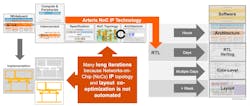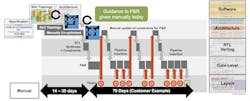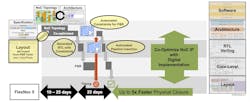Physically Aware Network-on-Chip Streamlines SoC Design Cycle
This video appeared in Electronic Design and has been published here with permission.
This video is part of TechXchange Talks.
Arteris IP has released FlexNoC 5, a network-on-chip (NoC) IP configuration tool, designed to improve system-on-chip (SoC) designs and streamline the design cycle. I spoke with Arteris IP's VP of Product Development, Andy Nightingale, about the company's physically aware NoC IP (see video above). The system is designed to provide an optimized, working NoC layout while significantly reducing the design-cycle time.
A NoC is a central component in SoCs these days, as they typically contain multiple cores, accelerators, memory blocks, and interfaces that need to communicate with each other. Timing and design challenges for these blocks is often easier than the NoC because they don't have to span the chip, which continues to get larger as more components are included. The challenge was automating the NoC layout and verification process (Fig. 1).
A typical design incorporating a NoC will take weeks to complete (Fig. 2). A significant amount of time is devoted to the manual changes to constraints during place and route (P&R) that are needed to create a working and optimized design. The actual synthesis is accomplished using automated tools, but the co-optimization has been done manually in the past since the designer understands the physical layout and constraints.
One of the many tasks involved in the co-optimization process is the design of the pipeline stages. That's because the timing of the NoC is spread across the SoC, and that distance and the time it takes for signals to move across it is significant (Fig. 3). The task isn't necessarily straightforward and some trial and error comes into play, especially when the system's other physical constraints enter the mix.
The FlexNoC 5 iteration understands the physical nature of the chip and automates the time details, such as pipeline insertion (Fig. 4). This results in fewer co-optimization iterations and simplifies the designer's role. It also can cut the amount of time required by a factor of five or more.
Reducing turnaround time is a key to improving time-to-market. FlexNoC 5 accomplishes this goal while improving the resulting SoC NoC design, enabling developers to focus on other areas of the chip.
Check out more videos in TechXchange Talks.
Links
About the Author
William G. Wong
Senior Content Director
I am Editor of Electronic Design focusing on embedded, software, and systems. As Senior Content Director, I also manage Microwaves & RF and I work with a great team of editors to provide engineers, programmers, developers and technical managers with interesting and useful articles and videos on a regular basis. Check out our free newsletters to see the latest content.>
You can send press releases for new products for possible coverage on the website. I am also interested in receiving contributed articles for publishing on our website. Use our template and send to me along with a signed release form.
Check out my blog, AltEmbedded on Electronic Design, as well as his latest articles on this site that are listed below.
You can my social media via these links:
- AltEmbedded on Electronic Design
- Bill Wong on Facebook
- @AltEmbedded on Twitter
- Bill Wong on LinkedIn
I earned a Bachelor of Electrical Engineering at the Georgia Institute of Technology and a Masters in Computer Science from Rutgers University. I still do a bit of programming using everything from C and C++ to Rust and Ada/SPARK. I do a bit of PHP programming for Drupal websites. I have posted a few Drupal modules.
I still get a hand on software and electronic hardware. Some of this can be found on our Kit Close-Up video series. You can also see me on many of our TechXchange Talk videos. I am interested in a range of projects from robotics to artificial intelligence.




